Author: founder of biancoresearch, compiled by Qin Jin
When can we really "test" Bitcoin spot ETF buyers? The average purchase price is approximately $57,000. Only then will we know how "strong" these buyers are?
I have always believed that Bitcoin spot ETFs have not seen a long-term strong upsurge of wealth management institutions getting together to buy. Instead, as with AI stocks (particularly NVDA and $MSTR), there has been an influx of short-term trading and speculative (degen) money into Bitcoin spot ETFs, which topped $1 billion/day earlier this week.
If I'm right, as the old Tradfi saying goes, take the elevator up, take the elevator down; these influxes of weak-hand speculative money could come rushing out, turning a correction into a rout . And this wave of outflows (or tokens) must immediately find a buyer at any price.
This may expose a design flaw in these Bitcoin spot ETFs (no physical transfer). If so, it risks undermining the promise of securing long-term adoption funding, which will take years, and even longer if the market starts to resemble a runaway casino.
Fund Flows
First, let’s look at the flow of funds to date. All 10 Bitcoin spot ETFs saw a combined $12 billion in inflows (black line). The picture below shows the daily traffic.
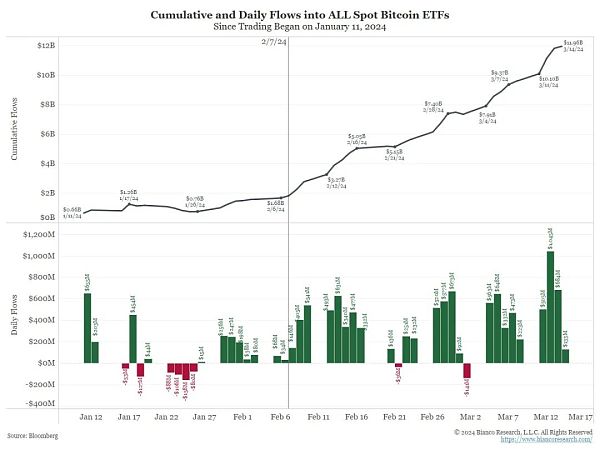
Some people believe that GBTC USD should be excluded. It seems to me that a significant portion of the funds (at least half) may have been moved from the high-fee $GBTC (150 basis points) to the low-fee Bitcoin spot ETFs (~30 basis points on average). Therefore, it should be included.
I will also include a set of "x-GBTC" charts as shown below. More than $23 billion flowed into 10 Bitcoin spot ETFs x-GBTC.
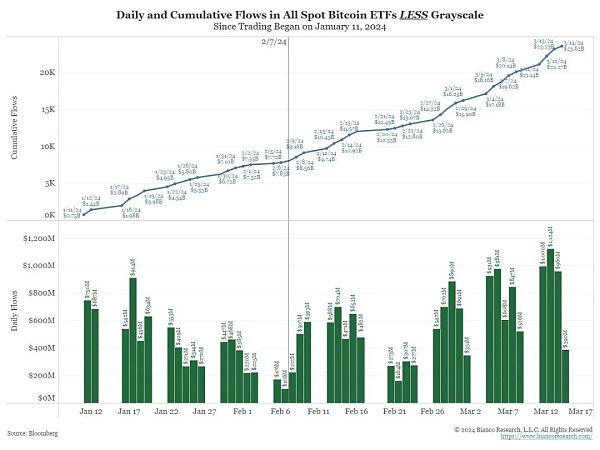
Average cost
Based on daily flow and price conditions, we can calculate the average purchase price (cost) of all incoming funds fairly accurately (again, not exact, but close enough). To do this, we average the Bitcoin spot price at 5 PM ET, weighted by daily inflows.
As shown in the figure, the average purchase point (cost) of $12 billion in spot BTC is $57,600 (orange line). The bottom panel shows that these ETF holders are sitting on $2.7 billion in unrealized profits (bottom panel).
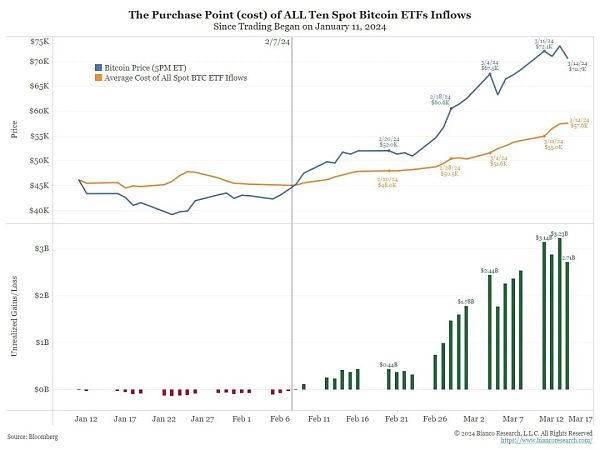
The following is the x-GBTC version. The average purchase point (cost) is $54.6k. Unrealized gains were $6.97 billion.
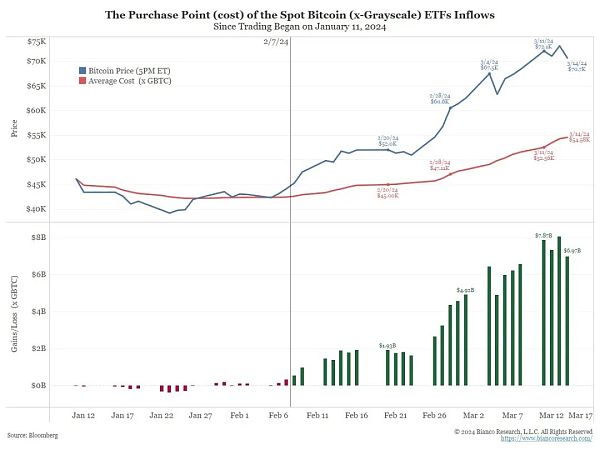
This suggests that a 20% correction would wipe out all their unrealized profits . Then what?
Everyone wants to believe they are Hodler. Maybe, but the evidence I've seen is that they all ran away.
What is the evidence?
First, know that no one knows who is buying these or any ETFs. We know they are buying, but are they retail investors, institutions, trading accounts, long-term endowments? ETFs trade transparency about who is buying for openness, allowing anyone to buy. (So while we have an informed opinion about them, that's just speculation on our part).
So anyone saying they are a wealth management firm is guessing (or more like hoping if they are an ETF provider). My anecdotal conversations with wealth managers indicate that they are interested in following these ETFs but will not promote them to clients. The only purchases through wealth managers are direct from clients. And these people are very, very few.
Trading Volume
So why do I think this is speculative money? The volume of transactions is astounding.
As shown, the daily trading volume of the two spot ETFs (orange) (486,230 trades on March 15 alone) exceeds $SPY (blue) or $QQQ (green) . On March 5, the trading volume of 10 Bitcoin spot ETFs was 709,820 times, exceeding the sum of SPY and QQQ!
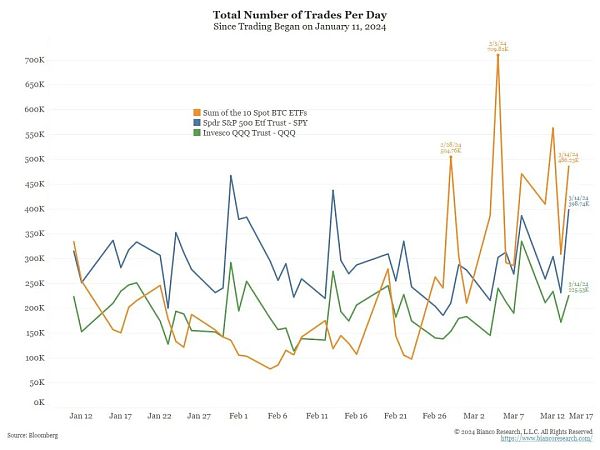
Therefore, the average transaction size of the 10 Bitcoin spot ETFs is only 17,000 USD (blue), compared to $55,000 for $GLD (orange), $101,000 for $QQQ (green), and $142,000 for $SPY.
To reiterate, these ETFs are being bought by fast money in small high-speed transactions. This is good on an uptrend, but can be even better on a pullback.
Conclusion
Bitcoin bulls in the upward trend say: When will you admit that you were wrong? They confidently say that these Bitcoin holders are entering a new asset class. They never sell and money comes in every month until the end of time.
Last Wednesday, brokerage JMP Securities said in a research report that the Bitcoin spot ETF may have an inflow of US$220 billion in the next three years, which means that if the multiplier of new capital is used, numbers, the price of BTC could quadruple to $280,000.
JMP analysts said cryptocurrency exchange Coinbase remains well-positioned if their estimates of capital inflows prove correct. The brokerage raised its target price on the stock to $300 from $220, the highest among Wall Street analysts, while maintaining its "outperform" rating, according to Factse data. As of March 14, Coinbase shares rose 2.6% to $262.92.
JMP stated that Coinbase is fully prepared and raised its target share price from $220 to $300. In addition, Wall Street giant JPMorgan Chase predicts that Bitcoin ETFs will have an inflow of $62 billion in the next two to three years.
While spot inflows into the Bitcoin ETF have exceeded expectations, reaching $10 billion just two months after launch, JMP said the process experienced so far (and Flows) are likely just the tip of the iceberg, adding that flows will continue to grow significantly as ETF approval is just the beginning of a "longer capital allocation process."
My answer is simple: let's see what happens when their unrealized gains disappear on the next 20% adjustment.
Look at an example, a variation of the image above.
In the first month of Bitcoin spot trading, BTC did correct by 20%.
And 40% of the funds left.
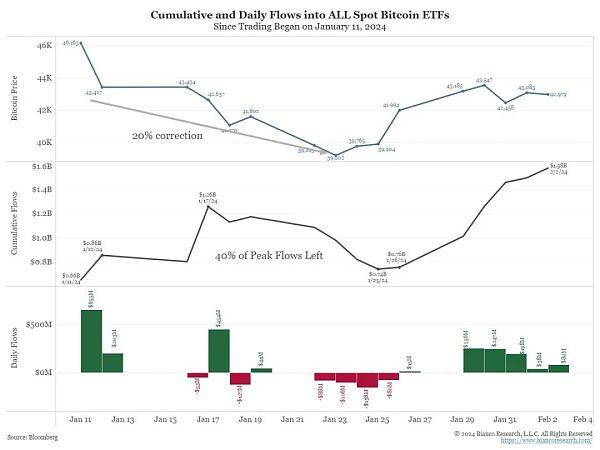
 JinseFinance
JinseFinance
 JinseFinance
JinseFinance Huang Bo
Huang Bo JinseFinance
JinseFinance JinseFinance
JinseFinance Beincrypto
Beincrypto Bitcoinist
Bitcoinist Bitcoinist
Bitcoinist Cointelegraph
Cointelegraph Cointelegraph
Cointelegraph Cointelegraph
Cointelegraph